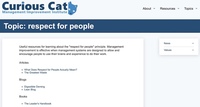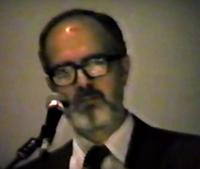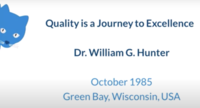Post highlightsby year:202520242023...2004
Post highlightsby tag:process improvementDeminglean manufacturinglean managementquality toolsmanagementcontinual improvementrespect for peoplemore tags
- I was a Lucky Kid

My father traveled a fair amount for work. It worked out well for us. I didn't realize until I was an adult having parents who loved you and made it obvious they did day to day is so valuable. That matters. Being gone sometimes didn't matter to me, I am sure some days it was annoying and is annoying for other kids. But it is really a minor blip, in my opinion.
- Using Deming’s Ideas – When Your Organization Doesn’t
- You can transform your understanding and how you learn, with an appreciation for the Theory of Knowledge and what conclusions you can and cannot draw from the data you use. You can transform how you act.
- View your organization with an understanding of Deming’s management ideas.
Think of the organization as a system. Even if you can’t persuade others to do this, you will understand the situation more clearly and be able to think of solutions that take advantage of this understanding. - ...
- Consider what is within your sphere of control. Within that sphere you will have much more freedom to act...
- Managing Our Way to Economic Success
there are two enormously valuable untapped resources in many companies: potential information and employee creativity. The two are connected. One of the best ways to generate potential information to turn it into kinetic information that can produce tangible results is to train all employees in some of the simple, effective ways to do this.
- Build an Environment Where Intrinsic Motivation Flourishes
50 years after Douglas McGregor’s classic, The Human Side of Enterprise, too many managers still have not learned that using extrinsic motivation is not an effective way to manage complex human systems (organizations)...
- Delighting Customers
If you have customers that see you as adequate you will keep customers based on inertia. But you have several big problems awaiting you.
Those trying to win your customers business only have to overcome inertia – which can be very low hurdle (saving a small bit of money, some minor additional feature). If your customers are delighted they won’t leave (by and large) without significant reasons to.
- Create a Continually Improving Management System - not the Perfect Management Solution
...Test out various options in parts of the company. See what works. Build and improve the process and spread it more widely...
- Curious Cat Management Improvement Institute

I have recently started publicizing the Curious Cat Management Improvement Institute
Curious Cat Management Improvement Institute is dedicated to furthering the education, professional growth and development of current and future managers and the practice of management in organizations.
Please let me know if you have comments, questions or suggestions for how to make the Curious Cat Management Improvement Institute useful to those trying to improve the practice of management.
- I Fear for the Future of the USA if We Do Not Vote in Favor of the Rule of Law this Year

I cannot fathom how anyone seeking political office in the USA that doesn't strongly speak out against someone with the horrendous track record Donald Trump has amassed during his life and the last 8 years can get even 5% of the USA population to consider voting for them. However, the USA public has shown that my beliefs are very different than many, at least it seems about 40% or maybe even more, voters. I fear we could not only elect him but also those that have not strongly spoken out against his hundreds of violations of criminal, ethical and other abuses against our society.
Details on some of the many abuses (frankly even 5% of which should disqualify anyone from supporting such an individual for any political office and most certainly from the most powerful political office in the USA):
- Design Your Organization to Serve Customers Well

Around all these processes is potential information. And you can either use it or not use it. And in most places just waste it.
…
There is valuable information just running down the drain. If you have everybody turned on and looking at process and saying how can we make them work better, you need to get some information, you need to get some data. That is the way you actually solve problems.William Hunter in seminar, Quality is a Journey to Excellence
- Parfrey’s Glen, Wisconsin

These photos show Parfrey's Glen in Wisconsin. It really was amazingly beautiful - the pictures do not do it justice. The light and colors were great - filtered through the trees above. The park is about an hour outside of Madison.
- Racism in the USA

...I read biographies of Reggie Jackson and I learned about how bad racism was very recently in the USA, from the few pages they included about what he had to endure. That left an enduring mark on my understanding of my society.
Here is a recent clip of him talking about some of his experience. It is extremely damaging that we have "leaders" today trying to erase history and deny current realities.
- Quality is a Journey to Excellence

I recently uncovered this 2 day management seminar that Bill Hunter (my father) recorded in 1985 in Green Bay, Wisconsin. The embedded clip shows the first section of a the seminar.
The present system in the US has not provided for any meaningful contribution from the workers themselves to improve the methods of production and the quality of work life. They have no opportunity to exercise their judgement, imagination, creativity or versatility in ways that could contribute to their productivity and sense of dignity. It is no surprise that they undergo frustration and discouragement, feelings certainly not apt to contribute to their efficiency. The solution to our productivity problem is the necessity for management and labor to recognize the intrinsic value of the human being.
Russell Schrader
- The USA Faces Extreme Risk if We Do Not Vote For Democracy and the Rule of Law in 2024

I am continually shocked and amazed at how far below (what I thought were low expectations) the Republican Party has managed to sink in the last 8 years. And it continually gets worse and more shocking. The country faces an enormous risk if we don't vote out those that have not strongly opposed the actions of the current Republican leadership this year. We need to rebuke their horrible behavior and vote those in power out of office, and keep those out of power today out of power forever.
...
I fear for the USA if we do not vote for those that oppose the abuses the Repubican Party has accepted and promoted the last 6 years.
- How to Safely Spend Savings in Retirement

There are no super simple answers in my opinion. But ideas like 4% (or 3.5% or …) do get you at least in the right ballpark for what has worked historically in the USA with specific portfolios
...
No one blog post is going to provide an answer to the question... There are some very good posts, articles and studies on the topic, here are a few:
- The Silliness of the Safe Withdrawal Rate Movement – “The correct answer to “what is a safe withdrawal rate?” is “something around 4%, probably in the 3%-6% range.” Not 3.59% or 4.21%.”
- Bill Bengen: How to Monitor and Adjust Withdrawal Plans
...
- Texas Civil Rights Project
I donated to the Texas Civil Rights Project.
It is a travesty what has been done for decades to suppress voting rights. We need those who have had their voting rights suppressed to help save the USA from the dangerous actions taken by those increasing their efforts to disenfranchise so many people.
Curious Cat blogs
Sites I Manage
Articles
- Good Process Improvement Practices
- How to Get a New Management Strategy, Tool or Concept Adopted
- Building a Great Software Development Team
- Using Quality to Develop an Internet Resource
- Encouraging Curiosity in Kids
- Purpose of an Organization
- How to Effectively Use of the PDSA Improvement Cycle
- Financial Market Meltdown
- Economic Strength Through Technology Leadership
- The Toyota Way - Two Pillars
- Diplomacy and Science Research
- Dangers of Forgetting the Proxy Nature of Data
- Awesome Cat Cam


